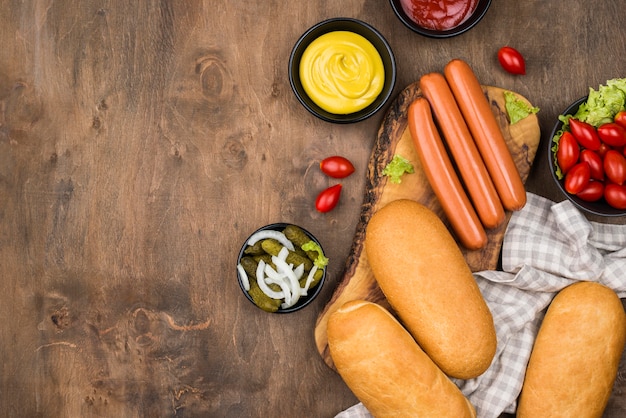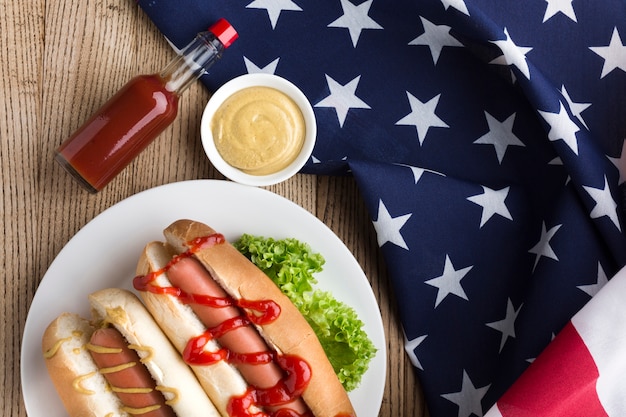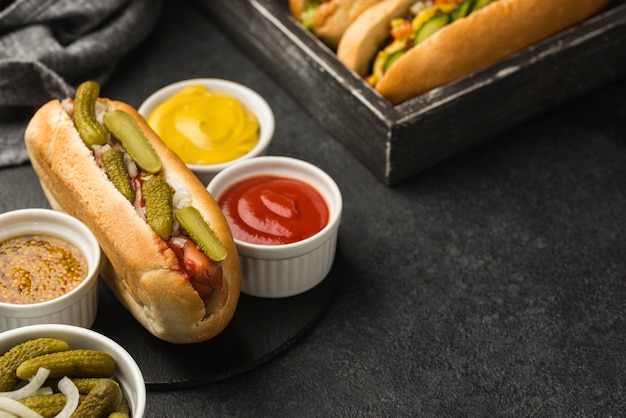Ah, the hot dog. A simple, yet satisfying culinary staple that sparks joy in the hearts of many. Whether you're tailgating at a football game, picnicking in the park, or just craving a quick and easy meal, there's something undeniably comforting about a juicy, perfectly cooked hot dog.
But let's be honest, achieving hot dog perfection can be a bit of a culinary tightrope walk. You don't want a rubbery, undercooked mess, but you also don't want to end up with a charred, overcooked disaster. That's where I come in, ready to share my years of experience and hot dog-related wisdom to help you master the art of hot dog cooking.
In this comprehensive guide, we'll dive into the world of hot dog cook times, exploring the best techniques for grilling, boiling, and even microwaving. We'll uncover the secrets to achieving optimal doneness, discuss the nuances of different hot dog types, and delve into the delightful world of toppings and variations.
Part 1: A Deep Dive into the Hot Dog

Before we start grilling, boiling, or zapping those hot dogs, let's take a moment to appreciate the marvel that is the humble hot dog. It's a seemingly simple food, but beneath its skin lies a world of culinary complexity.
The Ingredients and the Magic
Essentially, a hot dog is a sausage made from a blend of meats, typically pork and beef, though you'll find turkey, chicken, and even vegetarian options. These meats are finely ground, seasoned with spices, and then stuffed into a casing. The result? A delicious, versatile sausage that's ready to be transformed into a culinary masterpiece.
The Difference Between a Good Hot Dog and a Great One
Now, not all hot dogs are created equal. The quality of the ingredients, the blend of meats, and the seasoning all play a crucial role in the final flavour and texture. Some hot dogs are leaner, while others are more fatty, resulting in a juicier, but potentially less healthy bite. Additionally, the thickness of the hot dog and the type of casing can affect the cooking time and final texture.
So, as you embark on your hot dog journey, keep these factors in mind. Consider the type of hot dog you're using, and choose a cooking method and time that best suits its characteristics. Experiment with different brands and flavours to discover your personal favourites.
Part 2: Mastering the Grill

Let's face it, there's something undeniably satisfying about the smoky aroma of hot dogs grilling over a charcoal fire. It's a classic summer tradition and a surefire way to elevate your hot dog experience.
The Art of Grilling Perfection
Grilling hot dogs is a simple process, but there are a few key elements to keep in mind. First, pre-heating your grill is essential. A hot grill ensures even cooking and prevents the hot dogs from sticking. Aim for a medium heat, and keep an eye on those hot dogs to ensure they don't get charred too quickly.
Optimal Grilling Time
The ideal grilling time for a typical hot dog on a medium-heat grill is around 5-8 minutes. However, this is just a starting point. Consider the thickness and type of hot dog you're using. Thicker, all-beef hot dogs might take a bit longer, while thinner turkey dogs will cook faster.
The key is to watch those hot dogs closely. They should develop a nice golden brown colour and have a firm texture when gently poked. Don't overcook them! You want them to be cooked through but still retain their juiciness.
Grill Master Tips
Here are a few tips to ensure your hot dog grilling experience is a roaring success:
- Use tongs: Avoid piercing the hot dogs with a fork. This can lead to a loss of moisture and a less appealing texture.
- Flip those hot dogs: Rotating the hot dogs ensures even cooking and prevents them from sticking to the grill grates.
- Experiment with toppings: While classic mustard and relish combos are always a winner, don't be afraid to explore different topping options. Sauerkraut, chopped onions, chili, and even cheese can add a delicious twist to your grilled hot dog.
Part 3: The Boiling Method: Simplicity at its Finest

Boiling is a tried and true method for cooking hot dogs, perfect for those seeking a quick and easy meal. It's also a great option for larger gatherings, as you can easily cook a batch of hot dogs in a single pot.
Boiling Basics: The Essentials
To achieve perfect boiled hot dogs, start by ensuring you have enough water in your pot. You don't want the hot dogs crammed together. Bring the water to a rolling boil before adding your hot dogs. Overcrowding the pot can prevent the water from maintaining a vigorous boil, which will affect the cooking time and potentially lead to unevenly cooked hot dogs.
Boiling Time: The Key to Doneness
Typically, you'll need to boil your hot dogs for 5-7 minutes. However, as with grilling, the specific cooking time will depend on the type of hot dog and how many you're cooking. For example, thicker, all-beef hot dogs might need a bit more time to cook through than thinner, turkey dogs.
It's crucial to watch your hot dogs carefully. They should develop a slightly darker, more opaque color and have a firm texture when gently pressed. Avoid overcooking, as this will result in rubbery, dry hot dogs.
Boiling Tips for Success
Here are a few tips to enhance your hot dog boiling experience:
- Avoid overcooking: Keep an eye on the time and test the hot dogs for doneness to prevent them from becoming rubbery.
- Don't drain immediately: After boiling, allow the hot dogs to rest in the hot water for a minute or two. This will allow them to reabsorb some of the moisture and prevent them from drying out too quickly.
- Elevate the flavour: Add a few bay leaves or a pinch of black pepper to the boiling water for a subtle flavour enhancement.
Part 4: Microwave Magic: The Quick and Convenient Option
Sometimes, you just need a hot dog, and you need it fast. The microwave is a surprisingly effective way to cook a hot dog in a pinch. It's quick, convenient, and surprisingly versatile, though it may not provide the same delicious char or smoky flavour as grilling.
Microwave Power and Time
The ideal microwave cook time for a standard hot dog is typically 30-60 seconds on high power. However, this will vary based on the wattage of your microwave and the size of the hot dog. It's essential to watch your hot dog closely and adjust the time as needed.
Microwave Tips for Deliciousness
Here are some tips to maximise the flavour and texture of your microwaved hot dog:
- Use a microwave-safe dish: Avoid metal dishes as they can create sparks in the microwave.
- Add a little water: A tablespoon of water helps create steam and prevents the hot dog from drying out.
- Avoid overcooking: Microwaved hot dogs can quickly become overcooked and rubbery. Keep a close eye on them to prevent burning.
- Let it rest: After microwaving, let the hot dog cool for a few seconds before biting into it. This will prevent any potential burns.
Part 5: The Crucial doneness test: Ensuring Safety and Satisfaction
Whether you're grilling, boiling, or microwaving, it's essential to ensure your hot dog is cooked through to prevent any foodborne illnesses. There are a few ways to determine if your hot dog is cooked properly.
The meat thermometer: Your Culinary Ally
The most accurate way to check for doneness is by using a meat thermometer. Insert the thermometer into the thickest part of the hot dog. The internal temperature should reach at least 160°F (71°C).
Visual Cues: Signs of a Well-Cooked Hot Dog
If you don't have a thermometer, look for visual cues. The hot dog should have a slightly darker, more opaque color, and it should feel firm to the touch, not squishy.
The Pinch Test: A Simple, Reliable Method
You can also use the pinch test. Gently press the hot dog between your fingers. If it's cooked through, it will bounce back and feel firm. If it feels soft or mushy, it needs more cooking.
Part 6: Toppings, Toppings, Toppings: The Hot Dog’s Best Friends
So, you've cooked your perfect hot dog, and now it's time to unleash your creativity with the toppings! The possibilities are endless, and the combinations are as diverse as the hot dog itself.
classic hot dog toppings: A Timeless Tradition
Here are some classic toppings that have stood the test of time, offering a delightful balance of flavours and textures:
- Mustard: A tangy and spicy staple, adding a bold kick to your hot dog.
- Relish: Sweet, crunchy, and tangy, adding a delightful contrast to the hot dog's savoury flavour.
- Ketchup: A classic favourite, offering a sweet and savoury balance.
- Onions: Chopped white onions add a crisp crunch and a subtle sweetness, while red onions offer a sharper, more pungent flavour.
Beyond the Basics: Exploring New Hot Dog Horizons
But don't be afraid to explore beyond the classics! There are countless topping options to add a unique twist to your hot dog experience.
- Sauerkraut: Fermented cabbage adds a tangy and salty element, complementing the richness of the hot dog.
- Chili: A hearty and flavorful topping, perfect for those seeking a more substantial meal.
- Cheese: Melted cheddar, mozzarella, or even a sprinkle of parmesan can add a creamy, cheesy richness to your hot dog.
- Bacon: Yes, bacon! crispy bacon bits can elevate any hot dog, adding a smoky, salty crunch.
Part 7: A Global Hot Dog Odyssey: Styles From Around the World
The hot dog is a global sensation, with different cultures embracing this versatile sausage and adding their own unique twists and toppings.
The Chicago Dog: A Culinary Masterpiece
This iconic hot dog is a symphony of flavours and textures. It's typically topped with yellow mustard, chopped white onions, bright green sweet pickle relish, a dill pickle spear, a tomato wedge, a sprinkle of celery salt, and a dash of sport peppers. It's a true Chicago experience, and a testament to the city's culinary creativity.
The New York Street Vendor Hot Dog: A Simple Classic
In New York City, street vendors serve up a classic hot dog with mustard, ketchup, and a generous helping of sauerkraut. It's a simple, yet delicious combination that epitomizes the city's culinary energy.
The Korean Hot Dog: A Modern Twist
This inventive hot dog is wrapped in a crispy batter and served with a variety of toppings, such as ketchup, mayonnaise, and cheese. It's a fun and unique take on the classic, showcasing the fusion of culinary cultures.
Part 8: Debunking the Myths: Separating Fact from Fiction
Throughout its history, the hot dog has been shrouded in myths and misconceptions. Let's clear the air and separate the truth from the tall tales.
Myth 1: Hot Dogs Are Unhealthy
While hot dogs aren't exactly a health food, they can be part of a balanced diet. Choose leaner options like all-beef hot dogs and avoid those packed with preservatives. Remember, moderation is key, and enjoying a hot dog occasionally is perfectly fine.
Myth 2: Hot Dogs Are Made From Weird Stuff
This myth has been around for decades. Most hot dogs are made from a combination of meats, spices, and other ingredients. While some brands might use fillers like soy protein, it's not unusual and not necessarily a bad thing. Choose brands that you trust and read the labels carefully.
Myth 3: Hot Dogs Are Only for Kids
This is simply not true. Hot dogs can be enjoyed by people of all ages. They're a versatile food that can be dressed up or down, making them perfect for any occasion. From a simple street vendor hot dog to a gourmet, restaurant-style creation, the possibilities are endless.
Part 9: Frequently Asked Questions: A Guide to Hot Dog Knowledge
Here are some frequently asked questions about hot dog cooking, to help you conquer those culinary conundrums.
- What happens if I overcook my hot dog? It will become dry and rubbery. The hot dog will lose its moisture and develop a less appealing texture.
- How do I store leftover hot dogs? Store them in the refrigerator in their original packaging. They should last for 3-5 days.
- Can I freeze hot dogs? Yes, you can freeze them. Simply place them in a freezer-safe bag or container. They should last for 1-2 months.
- What's the best way to reheat a hot dog? Microwave it for a few minutes until heated through. You can also reheat it on the grill or in a pan over medium heat.
- What if I don't have a thermometer? Use the visual cues or the pinch test to check for doneness.
So there you have it, my fellow hot dog enthusiasts. With these tips and tricks, you're well on your way to becoming a hot dog master. Experiment with different cooking methods, explore the world of toppings, and most importantly, have fun with it! Whether you're grilling, boiling, or microwaving, you're sure to end up with a delicious and satisfying snack. Now, go forth and conquer the world of hot dog cooking!
Everyone is watching

How to Cook Frozen Lobster Tails Perfectly: A Step-by-Step Guide
RecipesLobster. Just the word conjures up images of lavish meals, special occasions, and a taste of luxury. But let's...

Pigs in a Blanket Cooking Time: How Long to Bake for Perfect Results
RecipesAh, pigs in a blanket. Just the name conjures up images of those delightful little parcels of crispy pastry en...

Pork Fillet Cooking Time: How Long to Cook It Perfectly
RecipesPork fillet, or tenderloin as it's sometimes called, is a real favourite in our house. It's so versatile, and...

The Ultimate Guide to Tender, Juicy Pulled Pork
RecipesRight, let's talk pulled pork. It's one of those dishes that just screams "comfort food," doesn't it? I mean...

The Ultimate Guide to Cooking Sweet Potatoes: From Roasting to Mashing
RecipesSweet potatoes. Just the name conjures up images of warm, comforting dishes, bursts of vibrant color, and a to...
